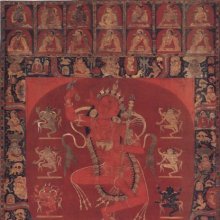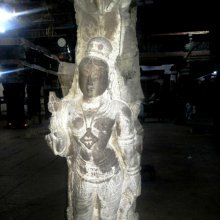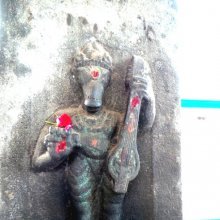Singer: 1 definition
Introduction:
Singer means something in Hinduism, Sanskrit. If you want to know the exact meaning, history, etymology or English translation of this term then check out the descriptions on this page. Add your comment or reference to a book if you want to contribute to this summary article.
Images (photo gallery)
In Hinduism
Shilpashastra (iconography)
Source: Shodhganga: Elements of Art and Architecture in the Trtiyakhanda of the Visnudharmottarapurana (shilpa)Singers refers to a certain class of personalities which follows specific guidelines in the tradition of ancient Indian Painting (citra), according to the Viṣṇudharmottarapurāṇa, an ancient Sanskrit text which (being encyclopedic in nature) deals with a variety of cultural topics such as arts, architecture, music, grammar and astronomy.—In the Viṣṇudharmottarapurāṇa, the rules of Painting of different classes have been elaborately discussed. Moreover, the costumes and accessories of different personalities in a picture are also described. The garments of bards, singers, dancers and musicians should be bright in colour.

Shilpashastra (शिल्पशास्त्र, śilpaśāstra) represents the ancient Indian science (shastra) of creative arts (shilpa) such as sculpture, iconography and painting. Closely related to Vastushastra (architecture), they often share the same literature.
See also (Relevant definitions)
Query error!
Full-text (+345): Gayaka, Gatri, Gandharva, Gayana, Geshna, Gathaka, Pragatri, Varnata, Carana, Gatu, Gathin, Geya, Svara, Vipra, Tumbaki, Vishvavasu, Geshnu, Gathakara, Gayika, Gavaiya.
Relevant text
Search found 180 books and stories containing Singer, Singers, The singer; (plurals include: Singers, Singerses, The singers). You can also click to the full overview containing English textual excerpts. Below are direct links for the most relevant articles:
Satirical works of Kshemendra (study) (by Arpana Devi)
5.8. The Singer (gāyana) < [Chapter 5 - Kṣemendra’s objectives of Satire]
1. Summary of the Kalāvilāsa < [Chapter 3 - Satirical Works of Kṣemendra]
7. Kṣemendra’s Observations < [Chapter 5 - Kṣemendra’s objectives of Satire]
Chandogya Upanishad (Madhva commentary) (by Srisa Chandra Vasu)
First Adhyaya, Sixth Khanda (8 mantras)
Second Adhyaya, Twenty-second Khanda (5 mantras)
Chandogya Upanishad (english Translation) (by Swami Lokeswarananda)
Note of Scepticism in Arun Kolatkar’s Jejuri < [October – December, 2008]
The Kathakali of Malabar < [November-December 1931]
Tagore’s Songs < [June 1948]
Puppetry in Assam (by Gitali Saikia)
Folk Theatre (e): Bharigan < [Chapter 6]
Folk Theatre (a): Kamrupia Dhulia < [Chapter 6]
Music used in puppetry of Assam < [Chapter 4]
Manusmriti with the Commentary of Medhatithi (by Ganganatha Jha)
Verse 3.184 < [Section IX - The Sanctifiers of Company]
Verse 4.215 < [Section XIV - Other Duties]
Verse 4.210 < [Section XIV - Other Duties]


